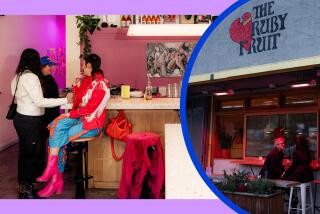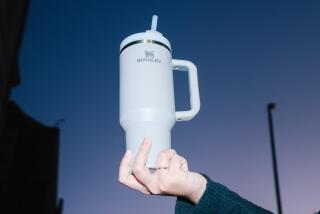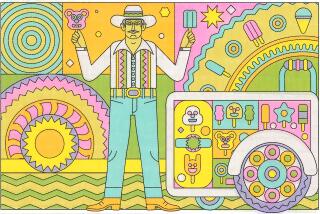Brooklynâs Seltzermen Refuse to Fizzle Out
NEW YORK â As the ancient diesel truck rumbled âround a corner in Brooklyn, the clinking of its glass cargo echoed across the decades.
Unlike the trolley, the soda fountain and the Dodgers, the seltzerman lives on in Brooklyn, refusing to fizzle out.
Despite the onslaught of plastic bottles and modern delivery trucks, a few hardy old souls deliver wooden crates filled with metal-spigotted glass bottles that most people only know from âThree Stoogesâ shorts on late night television.
âNo one wants to do this anymore,â seltzerman Ronny Beberman, 57, said on a recent run through northern Brooklyn. âItâs a lot of work and it doesnât pay so well.
âAfter 35 years, I donât know how much longer Iâll do it, and Iâm considered young for this business.â
Most of the 10 independent deliverymen, preferring more modern delivery vans, have forsaken the old-fashioned truck -- its side panel dangerously open, its bottles precariously stacked.
Do bottles ever fall out?
âIt happens,â Beberman said.
But he sticks to tradition, stirring long-forgotten memories among Brooklynites old enough to remember as he passes them on his route. His 150 customers are all in the borough. To meet demand, he starts his day early -- 5 a.m. -- and works six days a week. He charges $20 a case.
âPeople see the truck and stop me all over the place and ask me if I really am a seltzerman,â he said. âItâs a pretty unusual sight in this day and age.â
For younger residents, the truck is an apparition from a different time, if they know what it is at all.
âI had no idea that they ever delivered seltzer like that,â Vanessa Simpson, 24, said as Bebermanâs truck passed her on a street in Prospect Heights. âIt seems ... like something out of an old photograph or newsreel.â
After delivering several 60-pound boxes each holding 10 bottles and picking up empties from a home in Brooklyn Heights, the wiry, gray-haired Beberman paused for a moment to muse on all things bubbly.
âYou canât get this anywhere,â he said, swigging a spritz from his own personal bottle. âItâs so much better than the store-bought kind because that stuff goes flat the second you open it. Plus this stuff is triple-filtered.â
At the Gomberg Seltzer Works in another Brooklyn neighborhood, Canarsie, where Beberman fills his bottles, the triple-filtered process is the companyâs trademark. Not that it really matters: Itâs the only seltzer works left in town.
There, the last seltzermen haul in crate after crate of empty blown-glass bottles for refilling on âThe Monitorâ -- a machine built in London nearly 100 years ago, with a look thatâs positively industrial revolution.
âItâs still here because itâs always been here,â said Gombergâs third-generation owner, Kenny Gomberg. âWhen my grandfather started, this was the business.â
Although Gomberg now makes most of his earnings as a beer and soda wholesaler, he still keeps the Barnett & Foster siphon filler running because he knows what would happen if he shut it down.
âIf I stopped doing this, these few guys would be out of business,â he said. âItâs dying slowly. A decade ago, there were about 30 guys. Now itâs down to 10. People retire, guys pass away.â
The only other seltzer works in the region, Castle Seltzer in Derby, Conn., bottles its own brand and delivers to Connecticut, northern New Jersey and Manhattan.
Castle Seltzer owner Brian Dworkin, who helps others maintain their equipment with parts he has collected over the years, said he was aware of only four other seltzer works nationwide -- one in Pittsburgh, one in Florida and two in California.
During their heyday, from the 1920s through the 1950s, seltzermen delivered their wares across New York City and the country, alongside their brethren like the milkman and the ice man.
Today, most of the seltzermen who work out of Gomberg stay only in Brooklyn.
âI would say I deliver to about 100 families and maybe a dozen businesses,â seltzerman Steve Levine said recently as he filled his bottles at Gomberg. âBut only in Brooklyn, because itâs too hard to haul this stuff around.â
A 35-year veteran, Levine said each bottle -- mostly made in Eastern Europe in the early part of last century -- is a piece of history.
âThis is pure Americana. There are bottles from every state in the union, from towns and villages youâve never heard of. Remember, every town had a seltzer works,â he said.
Despite the age of the equipment and the dustiness of some of the bottles, itâs whatâs inside that counts, Levine said.
âThe bottles may look lousy, but whatâs inside is pure magic,â he said.
Back on the delivery route, the rattling of the bottles grew louder as Bebermanâs truck, its cab littered with broken bottle tops and papers, passed over cobblestone streets near the Brooklyn Navy Yard.
There are, it turns out, some limits to Bebermanâs nostalgia.
âThe best thing the city ever did was pave over the cobblestones,â he said. âThey may be pretty, but theyâre awful for the truck.â
More to Read
Sign up for Essential California
The most important California stories and recommendations in your inbox every morning.
You may occasionally receive promotional content from the Los Angeles Times.










